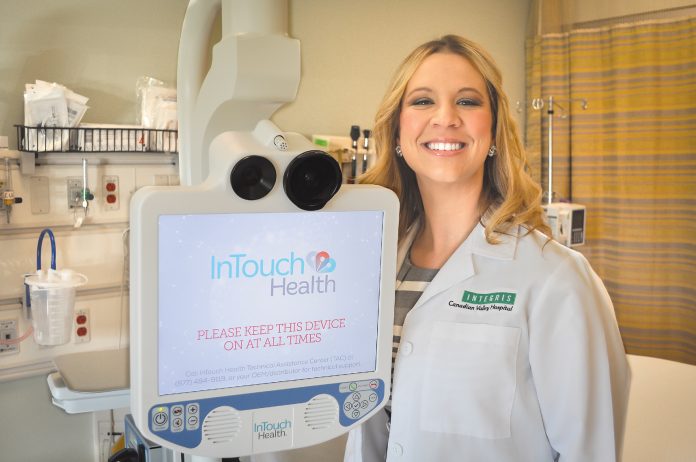
by Bobby Anderson
Staff Writer
Integris Canadian Valley Hospital is using technology to make a giant leap forward in improving outcomes of its stroke patients.
And thanks to a computer screen on wheels with high resolution cameras patients are getting the help they need anytime day or night.
Christine McMurray, RN-PCCN, serves as an administrative supervisor at Canadian Valley, and has served as the clinical coordinator for getting the new telestroke program off the ground.
“It’s kind of like a fancy-FaceTime where the physicians we have, the neurologists can beam in on the screen … and lenses can zoom all the way into their pupils and check pupil responses,” McMurray said.
Attached is a wired stethoscope that allows both the onsite clinician as well as the remote clinician to hear lung and heart sounds in real-time for those patients presenting with stroke symptoms.
The robot is controlled remotely and can be moved around the patient. The 360-degree microphone also captures sound from all directions inside the room.
The attached monitor screen allows both patient and doctor to have a face-to-face conversation as well as examination even if the doctor is hundreds of miles away.
“We were taking all of our stroke patients that required tPA to Southwest Medical and Baptist,” McMurray said. “Now what we can do after they are seen in the ER with telestroke we can give them tPA on a stable patient and bring them here for a neurology consult.
“Now, rather than shipping them out of Yukon they can stay here in town, in the community and neurology will beam in if there are no complications within 24 hours … they can prescribe the discharge medications, change any anti-coagulations medicines without physically being here but being present.”
Integris Canadian Valley Hospital Chief Nursing Officer Teresa Gray, RN, BSN, MBA said the technology offers immediacy for both doctor and patient.
“The doctor can basically do a full assessment from any device – iPhone, iPad, computers from anywhere anytime,” Gray said. “This technology allows for when you may not have services 24/7 in your facility and the patient has a change in their condition or you need a different level of care we have immediate access.”
“When you talk about neurology in the state of Oklahoma and there is a shortage of neurologists, this allows them to provide access to smaller communities that may not normally have neurologists and various high-level specialities that are hard to recruit. This gives the opportunity to bring that kind of service back to the smaller communities.”
Stroke is the fourth-leading killer in the United States and the leading cause of long-term disability.
Approximately 800,000 people experience a stroke each year in the US. Successful management of acute ischemic stroke is extremely time-dependent.
According to the American Heart Association, ideally, the only Food and Drug Administration-approved treatment for acute ischemic stroke should be administered within 3 hours of the onset of stroke symptoms.
The American Heart Association estimates that only 3% to 5% of ischemic stroke patients are treated with thrombolysis (a clotbuster known as tPA).
“They don’t have to be transferred out anymore. They don’t have to wait for a bed,” McMurray said of the major benefits of telestroke. “Baptist and Southwest have both been on delay several times. Then they have to go to the ER and they are put on hold there or are waiting in a hallway. Where here we’ve got eight ICU beds and they can come right over. They are treated with the same protocols and the same order sets. Everything is the same. If there is any problem all the physician has to do is come in over (Telestroke).”
The program is done in collaboration with the hospital’s hospitalist program which follows the plan of care throughout the course of a patient’s stay.
McMurray said the technology has already been used by the hospital’s two hospitalists to dial in remotely to check on other non-stroke patients who are experiencing changes in condition or acuity.
On average, Gray said Canadian Valley transfers out 7-8 stroke patients per month with lower-level patients not requiring tPA kept.
Gray said Canadian Valley continues to evolve its service offerings as it becomes the mainstay for healthcare for those living in Western Oklahoma.
“This is something cardiology and nephrology can use – any of our services that are not onsite 24/7,” Gray said. “That’s what we hope to expand is increase our complexity of patients, add additional services to the community we haven’t had and incorporate new technology.”













